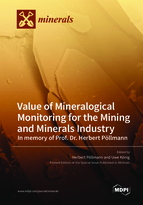Effects of Pyrite Texture on Flotation Performance of Copper Sulfide Ores
Round 1
Reviewer 1 Report
The paper deals with the problem of various copper ores flotation. Authors decided to investigate the influence of pyrite texture which can be framboidal and affects adversely the flotation performance. The paper can be treated as a study of examples of two types of ores originating from the same deposit.
Authors examined the flotation performance for two types of copper ores and a mixture of them. The first one floats quite easily and here pyrite did not represent a framboidal texture. Second one contained pyrite of framboidal/altered texture. Finally, the mixture was prepared in ratio 50:50.
The paper consists of four parts. The first one presents a review of similar works and the typical problems which can occur during flotation processes where pyrite takes part. Second part presents the materials used for experiments and the course of flotation process. Chemical composition of feeds are provided as well all reagents and their dosages used during tests were described. Third part shows main results and discussion. Not surprisingly, second type of ore, as well as a mixture floated much worse than the first one. Therefore, these two needed an additional treatment to improve their floatability. Last part shows main conclusions.
Generally, the paper is well planned. It deals with the problem of flotation, where new ways are always welcomed. In my opinion, these tests could be more detailed. The texture of pyrite was one of the features, but I think that more details could be taken into consideration making the paper even more scientifically sound. But, as an initial research it can be evaluated as a good one. Therefore, I find it appropriate to be published in Minerals.
Author Response
Please see the attachment
Author Response File: ![]() Author Response.docx
Author Response.docx
Reviewer 2 Report
Dear authors,
In your maniscript, described Ore B contains framboidal and altered pyrite/marcasite and does not respond the base flotation conditions. This was attributed to the framboidal and spongy, inclusionich, altered pyrite content and relatively high surface oxidation of altered marcasite particles.
Furthermore, based on the results, you have shown that surface cleaning by Na2S and depression of pyrite by MBS mitigated the negative effect of framboidal, spongy, altered pyrite from Ore B. Following the copper flotation, a high-grade pyrite concentrate could be produced from all ore samples.
Mineralogical investigation and chemical assays showed that Ore A has a relatively simpler ore texture and low Zn content.
I think the following should be done:
- Change the title of your manuscript, as follows: Optimization of flotation conditions of copper sulphide ores with different pyrite structures. You don’t have to accept this.
- Alternative flotation conditions were investigated to improve ore flotation performance. I would examine several samples with different mass contents of samples A and B.
- Explain the maintenance of pH values during grinding and flotation.
- Do you agree that large amounts of reagents were used in the experiment with sample B? A mixture of samples would give a realistic picture of flotation with optimal parameters.
- In these flotation conditions, it is possible to use sodium isopropyl xanthate, as well as dithiocarbamate
- Your results are well presented, but add my remarks to a couple of sentences.
With respect
Author Response
Please see the attachment.
Author Response File: ![]() Author Response.docx
Author Response.docx
Reviewer 3 Report
Effects of Pyrite Texture on Flotation Performance of Copper
Sulfide Ores is very interesting paper. Some improvement is required.
Line 14: copper (sulphidic) ores and develop
Line 26: The copper recovery could be increased to 52% Cu for Ore B, and 65% for the mixed ore sample (why). This sentence is not complete
Line 57: marcasite (please to write chemical formula) is more reactive than pyrite and reacts...
Line 114: Table 1. Chemical composition of Ore A and Ore B on a size by assay basis. (no gold and arsenic in these samples?)
Line 143: flotation feed was ground to p80:38µm (please to check it. What is the meaning of "p") in a ball mill at 60% w/w pulp density.
Line 249: increase the dissolved oxygen content and Eh to slightly positive values (please to write these values!). What are pH-VAlues at the same time?
Line 266: Figure 6 shows that the highest copper grade values were obtained in the presence of MBS, because of effective depression of pyrite (Please to check this picture. MAybe the best values are with an addition of NaHS)
Line 271: During plant scale operation (which quantity of materials?), it may not be possible to always separate Ore B from ..
Line 295: Table 8 shows the results of the simulation studies for Ore A, Ore B and their mixture (Did you use some software for simulation?)
Line 386: metabisuphite (change to metabisulphite) on pure pyrite and pyritic copper ore flotation.
Author Response
Please see the attachment.
Author Response File: ![]() Author Response.docx
Author Response.docx






